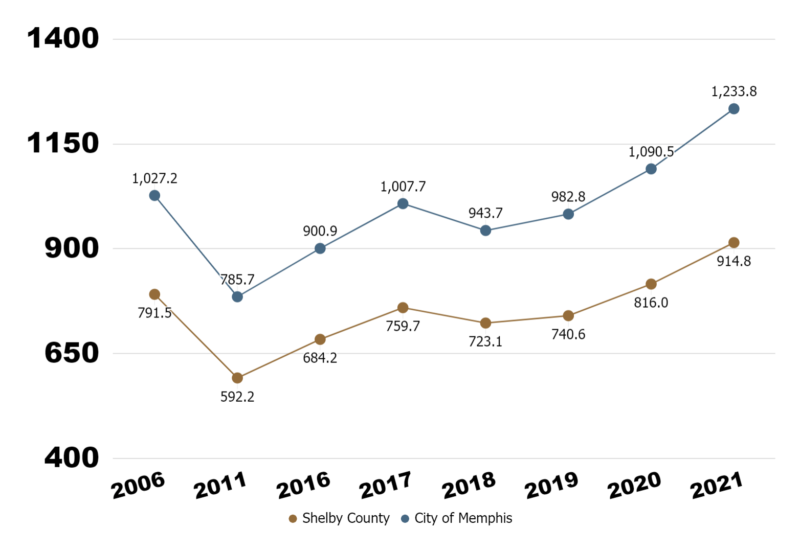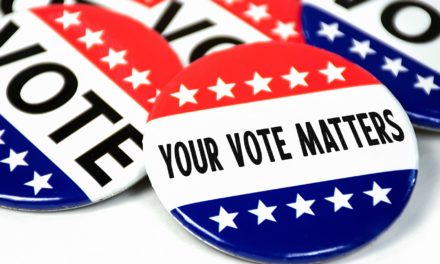Table Above: Major Violent Crime
It’s hard not to pity the people at Memphis Branding AKA WeAreMemphis.com these days.
While it’s hard to discern the impact of the four-year program, its work has to be complicated by things like the results of Memphis Shelby Crime Commission’s recent crime poll with media headlines indicating the public’s growing fear of violent crime.
“Memphis Brand Initiative is an organization with a goal of elevating the Memphis/Shelby County’s global reputation by defining the authentic and essential brand identify and communicating it in a newly strategic and coordinated way, objectives are to recruit and retain talent, tourists, and businesses, and strengthen civic pride among Memphians,” according to the mission of the organization largely unknown by most members of the public.
It’s an ambitious mission statement and absent any public reporting or an annual report, it’s not possible to say if it’s successful.
And yet, it hardly matters if it spends millions of dollars every year to improve the Memphis brand and present its best side when Memphis Shelby Crime Commission is paying for polls aimed at generating fear-invoking headlines to build support for its agenda, and at the same time become negative fodder in the competition for talent, jobs, and population growth.
All Right All Ready
I’m not suggesting that we shouldn’t be transparent about crime concerns. After all, we hear about it almost every Friday in the mayor’s email blast and the rising violent crime is reflected in rising anxiety among Memphis families, including some inveterate Memphis boosters now considering a move out of the city.
There’s really no risk that anyone in this area will ever forget the impact of violent crime, particularly as long as WREG-TV exists, but the Crime Commission’s poll is a megaphone that regularly shouts out about it as it pushes a specific policy agenda.
Research has shown the connection between media coverage of crime and public concern about it. It’s a contributing factor, but these days, The Commercial Appeal covers crimes if they have unusual importance, Daily Memphian generally acts like crime doesn’t exist, while WREG continues its long tradition of “blood in the streets” coverage.
It was once easy to criticize Channel 3 for its unrelenting coverage of crime, but these days, the crime rate is at a rate where it’s difficult to deny its news value. To point out the impact that WREG has on local opinion, it has more visitors to its website than Daily Memphian and Commercial Appeal combined. Here are the number of monthly visitors to the websites in September:
Daily Memphian – 693,990
Commercial Appeal – 1,570,000
WREG-TV – 3,720,000
Not The Headline We Needed
Into this mix came the recent release of the poll by the Crime Commission. In its previous incarnation, it was measuring police-community relations, but this time around, it asked questions which appear designed to bolster its own strategies.
The poll showed 81% of registered voters (only polling registered voters is a tell about its political purpose) support hiring more police officers and 15% opposed. Black and white respondents polled evenly on hiring more police officers, with 84% of white voters supporting it and 80% of Black respondents.
The poll found that 73% of voters countywide support loosening requirements so police and firefighters can live in a neighboring county or within a 50-mile radius. Another 24% oppose changing the residency requirement.
In addition, it resurrected the political favorite of suggesting the criminal justice system is too lenient. According to the poll, 37% of registered voters see the system as “too lenient” rather than “too harsh” for both youth and adult offenders. White voters and African American voters differ on the treatment of adults while being nearly aligned on the treatment of juveniles.
A day later, Mayor Strickland’s weekly email suggested the symbiotic relationship with the Crime Commission as he raised the issue, blaming lenient courts for a heinous crime.
More than anything, the poll results were a direct hit on the mayor’s priorities since it can be interpreted as a lack of confidence in his ability to reduce crime, but it’s more than that. It also hurts his stated goal of attracting more population and economic growth which is dependent on talent by undermining the power of a positive brand to attract them to Memphis.
An Incestuous Arrangement
The poll is but a part of an incestuous arrangement that breeds a lack of imagination and innovation in crime prevention, that propels strategies that are clearly failing, and that eliminates independent analysis and recommendations.
It’s not uncommon for the University of Memphis Public Service Institute headed by Bill Gibbons to make recommendations to the Crime Commission headed also by Bill Gibbons and when the Crime Commission recommendations are adopted by city government, their effectiveness is evaluated by the Public Service Institute where they originated in the first place.
Despite this major impact on policy, the Institute and Commission are not known for their transparency. MLK50 and Marshall Project had to file a lawsuit for the Crime Commission to be more transparent about the $6.1 million it raised so City of Memphis could recruit and retain police officers.
Along the way, both the Institute and Commission shed cloaks of impartiality to advocate politically. That’s where the recent poll comes in. It’s used to support favorite answers from the Institute and Commission like hiring more and more police officers, eliminating hiring requirements for Memphis police officers to live in Shelby County, and urging tougher and longer sentences.
As the Crime Commission approaches its 25th anniversary and in light of Memphis having one of the highest crime rates among the U.S. largest cities, it’s hard to argue that its leadership is succeeding in its motto: “Making Memphis and Shelby County a safer place.”
Its guidance has not just failed to produce positive results in reducing violent crime but it has blown a hole in Mr. Strickland’s top priority as a candidate and as a mayor – reducing Memphis’ crime rate.
Tough Time For The Mayor’s Priority
It’s hard not to think of this each time the latest violent crime statistics from Memphis Shelby Crime Commission are released. Major violent crime measures murders, manslaughter, justifiable homicide, forcible rape, and aggravated assaults.
The news release with the latest numbers usually starts with property crime. Its rate is reduced but it’s not the data point that most Memphians are interested in. Then there’s the overall crime rate, which is also down but also not what people are most interested in. Then comes major violent crime, which has risen 13.1% when compared to last year and 20.1% compared to 2006. The Crime Commission and others like to use 2006 because crime spiked that year and overall, it has made statistics look like an improvement.
However, in the last report, for January to June, 2021, major violent crime was even higher than 2006, and when the trend line starts with 2016, when Jim Strickland was elected Memphis mayor, violent crime has risen in five out of six years.
Here are the number of major violent crime incidents per 100,000 population for January-June with the number of incidents followed by the year:
6,836 – 2006
5,150 – 2011
5,883 – 2016
6,564 – 2017
6,150 – 2018
6,398 – 2019
7,085 – 2020
8,013 – 2021
Careful What You Wish For
It’s a safe bet that no one in Memphis is as frustrated about the rising violent crime rate as the mayor himself. After all, his resounding victory over former Mayor A C Wharton was largely based on the dramatic “Friday Night Lights” television commercial that was pivotal in moving voters to the Strickland column on the single issue of him being better than the incumbent in fighting crime.
Here’s the thing: It’s a delicate balance. It’s about raising crime prevention as a priority by the political class without it swamping positive messages that are needed to reverse Memphis’ population loss. All in all, it’s enough to make you wonder how many people are paying attention to the PR about neighborhood park improvements when it’s out-of-control crime that is hammered day after day.
Of the 50 largest cities in the U.S., only four cities lost population. Memphis was one of them along with Detroit, Milwaukee, and Baltimore. Appearing near hysteria about crime is not the way to assure the public that you’re serious about fighting it or encouraging people to move to the city and stay in it.
It’s about creating perspective. Some indication that there is coordination between City Hall messaging and the Branding Initiative messaging would be a step in the right direction so that they are not in conflict.
For that matter, it would be helpful if a comprehensive, clear branding plan were presented to the public. Now, there’s messages from city government, county government, Memphis Tourism, Downtown Memphis Commission, Greater Member Chamber and Memphis Branding Initiative.
There’s never been a time when Memphis needs to get significant return on the branding investments being made, but it calls for a level of cooperation and coordination unseen for way too many years. If the present trajectory of the community isn’t reason enough to get serious, nothing is.
**
Join us at the Smart City Memphis Facebook page for daily articles, reports, and commentaries relevant to Memphis.




